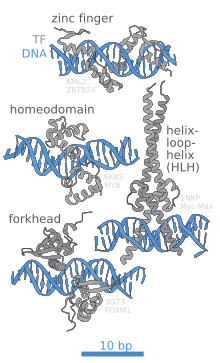
Back مواقع ربط الحمض النووي Arabic DNT-nin bağlanma sahəsi Azerbaijani محل اتصال دیانای Persian DNA结合位点 Chinese

DNA binding sites are a type of binding site found in DNA where other molecules may bind. DNA binding sites are distinct from other binding sites in that (1) they are part of a DNA sequence (e.g. a genome) and (2) they are bound by DNA-binding proteins. DNA binding sites are often associated with specialized proteins known as transcription factors, and are thus linked to transcriptional regulation. The sum of DNA binding sites of a specific transcription factor is referred to as its cistrome. DNA binding sites also encompasses the targets of other proteins, like restriction enzymes, site-specific recombinases (see site-specific recombination) and methyltransferases.[1]
DNA binding sites can be thus defined as short DNA sequences (typically 4 to 30 base pairs long, but up to 200 bp for recombination sites) that are specifically bound by one or more DNA-binding proteins or protein complexes. It has been reported that some binding sites have potential to undergo fast evolutionary change.[2]
- ^ Halford E.S.; Marko J.F. (2004). "How do site-specific DNA-binding proteins find their targets?". Nucleic Acids Research. 32 (10): 3040–3052. doi:10.1093/nar/gkh624. PMC 434431. PMID 15178741.
- ^ Borneman, A.R.; Gianoulis, T.A.; Zhang, Z.D.; Yu, H.; Rozowsky, J.; Seringhaus, M.R.; Wang, L.Y.; Gerstein, M. & Snyder, M. (2007). "Divergence of transcription factor binding sites across related yeast species". Science. 317 (5839): 815–819. Bibcode:2007Sci...317..815B. doi:10.1126/science.1140748. PMID 17690298. S2CID 21535866.
© MMXXIII Rich X Search. We shall prevail. All rights reserved. Rich X Search